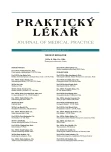Basics of social cognitive and affective neuroscience; XIV. Cultural neuroscience
Authors:
F. Koukolík
Authors‘ workplace:
Primář: MUDr. František Koukolík, DrSc.
; Národní referenční laboratoř prionových chorob
; Thomayerova nemocnice, Praha
; Oddělení patologie a molekulární medicíny
Published in:
Prakt. Lék. 2012; 92(2): 67-71
Category:
Editorial
Overview
Cultural neuroscience is a new discipline that investigates cultural variation in psychological, neural and genomic processes. Culture and genes are often thought of as at opposite ends of the nature-nurture spectrum but interactions do exist: genetic variation may interact with ecological and social factors to influence cultural differences. There are, for example,
- cross-cultural differences in children’s choices, categorizations, and evaluation of truths and lies,
- culturally specific personality traits (in so-called independent and interdependent cultures),
- differences in perception (analytic vs. holistic, local vs. global processing),
- reading,
- writing,
- arithmetic processing,
- semantic relationships,
- memory,
- emotions, and
- empathy.
Key words:
cultural neuroscience, genes, neurobiology, behaviour, cultural traits.
Sources
1. Adams, R.B. Jr., Rule, N.O., Franklin, R.B. Jr. et al. Cross-cultural reading the mind in the eyes: an fMRI investigation. J. Cogn. Neurosci. 2010, 22, p. 97-108.
2.Avenanti, A., Sirigu, A., Agliotti, M. Racial bias reduce sensorimotor resonance with other - race pain. Curr. Biol. 2010, 20, p. 1018-1022.
3.Blais, C., Jack, R.E., Scheepers, Ch. et al. Culture shapes how we look at faces. PLoS One, 2008. e3022.doi:10.1371/Journal.pone.001903022.
4.Bolger, D.J., Perfetti, Ch.A, Schneider, W. Cross-cultural effect on the brain revisited: universal structures plus writing system variation. Hum. Brain. Mapp. 2005, 25, p. 92-104.
5. Butler, E.A., Lee, T.L., Gross, J.J. Emotion regulation and culture: are the social consequences of emotion suppression culture-specific? Emotion 2007, 7, p. 30-48.
6. Costa, P.T., McCrae, R.R. NEO PI-R professional manual. Odessa, FL: Psychological Assessment Resources, 1992.
7. Fu, G., Xu, F., Cameron, C.A. et al. Cross-cultural differences in children’s choices, categorizations, and evaluations of truths and lies. Dev. Psychol. 2007, 43, p. 278-293.
8. Goh, J.O.S., Leshikar, E.D., Sutton, B.P. et al. Culture differences in neural processing of faces and houses in the ventral visual cortex. SCAN 2010, 5, p. 227-235.
9. Goh, J.O.S., Chee, M.W., Tan, J.C. et al. Age and culture modulate object processing and object - scene binding in the ventral visual area. Cogn. Affect. Behav. Neurosci. 2007, 7, p. 44-42.
10. Gutchess. A.H., Hedden, T., Ketay, S. Neural differences in the processing of semantic relationships across cultures. SCAN 2010, 5, p. 254-263.
11. Hedden, T., Ketay, S., Aron, A. et al. Cultural influences on neural substrates of attentional control. Psychol. Sci. 2008, 19, p. 12-16.
12. Heine, S.J., Buchtel, E.M. Personality: the universal and the culturally specific. Annu. Rev. Psychol. 2009, 60, p. 369-394.
13. Cheon, B.K., Mathur, V.A., Chiao, J.Y. Empathy as a cultural proces: insights from the cultural neuroscience of empathy. WCPRR 2010 Summer: p. 32-42. Dostupné na www.wcprr.org/pdf/05-01/2010.01.32-42.pdf.
14. Chiao, J.Y., Iidaka, T., Gordon, H.L. et al. Cultural specificity in amygdala response to fear faces. J. Cogn. Neurosci. 2008, 20, p. 2167-2174.
15. Chiao, J.Y. Cultural neuroscience: visualizing culture-gene influences on brain function. In: Decety J, Caccioppo J. (eds.). Handbook of Social Neuroscience. Oxford: Oxford University Press, 2011. Dostupné na http://research.chicagobooth.edu/ cdr/docs/Chiao-Handbook.pdf.
16. Chua, H.F., Boland, J.E., Nisbett, R.E. Cultural variation in eye movements during scene perception. Proc. Natl. Acad. Sci. USA 2005, 102, p. 12629-12633.
17. Kitayma, S., Duffy, S., Kawamura, T. et al. Perceiving and object and its context in different cultures. A cultural look at new look. Psychol. Sci. 2003, 14, p. 201-206.
18. Kobayashi, Ch., Glover, G.H., Temple, E. Cultural and linguistic effects on neural bases of „Theory of Mind“ in American and Japanese children. Brain Res. 2007, 1164, p. 95-107.
19. Koukolík, F. Před úsvitem, po ránu. Eseje o dětech a rodičích. Praha: Karolinum, 2008, s. 177.
20. Koukolík, F. Evoluční psychologie. Prakt. lék. 2010, 90(9), s. 511-514.
21. Koukolík, F. Základy sociální, kognitivní a afektivní neurovědy. I. Úvod. Prakt. lék. 2010; 90(12), s. 695-700.
22. Koukolík F. Základy sociální, kognitivní a afektivní neurovědy. XV. Osobnost. Prakt. lék. 2012; 92, v tisku.
23. Mesquita, B., Leu, J. The cultural psychology of emotion. In: Kitayama S, Cohen S (eds.) Handbook of cultural psychology. New York: Guilford Press 2007.
24. Nisbett, R.E., Masuda, T. Culture and point of view. Proc. Natl. Acad. Sci. 2003, 100, p. 11163-11170.
25. Nisbett, R.E., Miyamoto, Y. The influence of culture: holistic versus analytic perception. Trends. Cogn. Sci. 2005, 9, p. 467-473.
26. Petersson, K.M., Silva, C., Castro-Caldas, A. et al. Literacy: a cultural influence on functional left-right differences in the inferior parietal cortex. Eur. J. Neurosci. 2007, 26, p. 791-799.
27. Tang, Y., Zhang, W., Chen, K. et al. Arithmetic processing in the brain shaped by cultures. Proc. Natl. Acad. Sci. 2006, 103, p. 10775-10780.
28. Xu, X., Zuo, X., Wang, X. et al. Do you feel my pain? Racial group membership modulates empathic neural responses. J. Neurosci. 2009, 29, p. 8525-8529.
29. Yamagata, S., Suzuki, A., Ando, J. et al. Is the genetic structure of human personality universal? A cross-cultural twin study from North America, Europe, and Asia. J Pers. Soc. Psychol. 2006, 90, p. 987-998.
30. Way, B.M., Lieberman, M.D. Is there genetic contributions to cultural differences? Collectivism, individualism and genetic markers of social sensitivity. SCAN 2010, 5, p. 203-211.
Labels
General practitioner for children and adolescents General practitioner for adultsArticle was published in
General Practitioner

2012 Issue 2
- Hope Awakens with Early Diagnosis of Parkinson's Disease Based on Skin Odor
- Advances in the Treatment of Myasthenia Gravis on the Horizon
- Memantine Eases Daily Life for Patients and Caregivers
- Metamizole at a Glance and in Practice – Effective Non-Opioid Analgesic for All Ages
- Memantine in Dementia Therapy – Current Findings and Possible Future Applications
Most read in this issue
- Gluten enteropathy
- Subliminal perception, medicine and addictive diseases
- Primary prevention in general practitioner surgeries
- Electronic documentation for nursing diagnostics in home care
